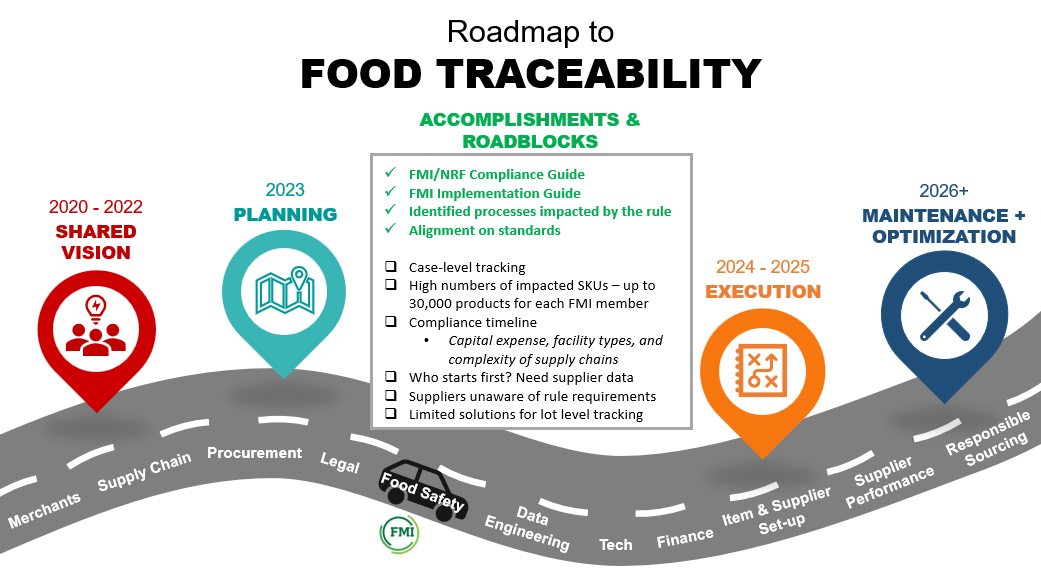By Heather Garlich, Senior Vice President, Communications, Marketing & Consumer/Community Affairs, FMI, and Andy Harig, Vice President, Tax, Trade, Sustainability & Policy Development, FMI

Did you know that a holiday fruitcake has a half-life? Okay, you caught our bluff for this clickbait post, but most cakes and muffins can remain fresh three to seven days from the date of purchase, or six months if you freeze them. Grandma’s casserole and other leftovers should be stored in a refrigerator for up to four days to ensure a safe, quality experience. With the holiday season upon us, it’s important to recognize and share tips with shoppers for how they can enjoy their holiday meals to the fullest - even leftovers - mitigating unnecessary food waste. We’re reminded as the season gets into full swing that U.S. businesses and consumers combined throw away an estimated 30% to 40% of the food that is grown, processed, and transported annually.
For consumers, the solution is simple but takes practice and commitment: Plan as many meals as possible as far in advance as you can – especially when entertaining. Scheduling meals cuts down on food waste; makes it easier to set a weekly or monthly grocery budget; saves money by helping you only purchase what you need; and allows shoppers to buy in bulk for staples to cook at home.
One learned habit during our pandemic days seems to be sticking, as 33% of shoppers told us that the pandemic helped them successfully avoid food waste. Among the necessary tools for any kitchen, including a thermometer and following safe food handling practices, The FoodKeeper app is a terrific digital advisor. This resource was developed by U.S. Department of Agriculture, Cornell and FMI to offer valuable food storage guidelines.
Growing consumer interest in minimizing food waste also represents an emerging opportunity for food retailers to further their commitment to being responsible partners in their communities.
Food retailers have consistently been the largest private donors of meals to the Feeding America network of food banks. Food retailers donated 1.7 billion meals in 2021 alone – contributing more than a quarter of the total 6.6 billion meals donated. And - aligned with our White House Conference on Nutrition and Health Commitments - the food industry has committed to donating two billion meals in 2023.
The food industry is also increasingly leveraging data-driven approaches to develop more efficient inventory management strategies to help reduce spoilage, over-ordering, and food waste. Food waste is extremely expensive for retailers, which creates an economic and environmental incentive to buy into programs that reduce waste across the board.
Given that Americans have shown an increased desire to purchase prepared food options, with foodservice/prepared foods sales surging to $31.3B in the first half of this year, retailers are proactively working to repurpose the products that don’t sell and might normally go to waste into grab-and-go items like pre-made salads and pies. Our Power of Foodservice at Retail suggested that grocers can promote meal components for cooking so that supermarkets become a one-stop shop for different types of meal preparation or they can offer savings at a time of higher prices through strategies such as discounts for foodservice meal bundles. Collectively, these foodservice at retail activities can reduce food waste while creating brand differentiation via ready-to-eat products shoppers love.
This holiday season, set the table for delicious, safe and affordable food options and a conscious effort to make the most of your menu.


 Industry Topics address your specific area of expertise with resources, reports, events and more.
Industry Topics address your specific area of expertise with resources, reports, events and more.
 Our Research covers consumer behavior and retail operation benchmarks so you can make informed business decisions.
Our Research covers consumer behavior and retail operation benchmarks so you can make informed business decisions.
 Events and Education including online and in-person help you advance your food retail career.
Events and Education including online and in-person help you advance your food retail career.
 Food Safety training, resources and guidance that help you create a company food safety culture.
Food Safety training, resources and guidance that help you create a company food safety culture.
 Government Affairs work — federal and state — on the latest food industry policy, regulatory and legislative issues.
Government Affairs work — federal and state — on the latest food industry policy, regulatory and legislative issues.
 Get Involved. From industry awards to newsletters and committees, these resources help you take advantage of your membership.
Get Involved. From industry awards to newsletters and committees, these resources help you take advantage of your membership.
 Best practices, guidance documents, infographics, signage and more for the food industry on the COVID-19 pandemic.
Best practices, guidance documents, infographics, signage and more for the food industry on the COVID-19 pandemic.
